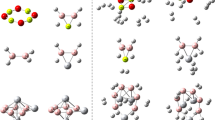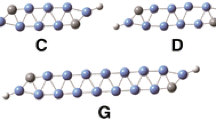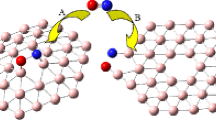Abstract
An all-electron calculations on BenH2O (n = 2–13) clusters have been performed by using density functional theory with the generalized gradient approximation at the PW91 level. The results show that H2O molecule tend to be adsorbed on the surface of pure Ben clusters in parallel and occupy the outer positions of beryllium clusters. After adsorption, the structure of most clusters changes obviously, and the symmetry is also decreased. The adsorption of beryllium clusters toward H2O molecule is relatively strong for n = 6, 7, and relatively weak for n = 4, 10, 13. And, the length of most Be–Be bonds become shorter, while the length of H–O bonds become longer or even break. In other words, the adsorption of water molecule will enhance the Be–Be interaction and weaken the H–O interaction. Compared with pure Ben clusters, the energy gap of BenH2O is significantly improved. With the increase in atom number, the vertical ionization potential of the clusters gradually decreases, while the vertical electron affinities gradually increases. The stability of pure Ben clusters is greatly affected by the adsorption of H2O. The H–O bond length, Be–Be bond length and HOMO–LUMO gap of the clusters are changed enormously. In order to consider the effect of weak interaction in water molecule on BenH2O clusters, we use DFT-D to modify the above results. The results of DFT-D are almost the same as that of DFT, and the magic number structure Be7H2O still exists after adsorption.







Similar content being viewed by others
Data Availability Statement
This manuscript has no associated data or the data will not be deposited. [Authors’ comment: The data described in this manuscript has no associated date.]
References
Y. Hang, W. Yang. Adsorption mechanism of hydrazine and methane on Li3B12 cluster: DFT investigations. J. Struct Chem. 163 (2023)
A. Pangh, M. Ghaemi, M.D. Esrafili et al., NO adsorption on Ni4M (M = Ni, Mo, Sc, and Y) nanoclusters: a DFT study. J. Nanopart. Res. 24, 49 (2022)
M. Salazar-Villanueva, A.B. Hernandez, J.F. Mendez et al., Adsorption of CO and NO molecules onto pentagonal clusters of aluminum: a DFT study. J. Mol. Model. 23, 332 (2017)
J.Y. Zhao, F.Q. Zhao, H.X. Gao et al., DFT studies of the adsorption and dissociation of H2O on the Al13 cluster: origins of this reactivity and the mechanism for H2 release. J. Mol. Model. 19, 1789–1799 (2013)
E. Kadossov, U. Burghaus, Adsorption dynamics of CO on silica supported gold clusters: cluster size effects in molecular beam scattering experiments. J. Catal Lett. 134, 228–232 (2010)
A. Corma, M. Boronat et al. On the activation of molecular hydrogen by gold: a theoretical. J. Chem. Commun. 3371–3373 (2007)
H.W. Fan, J.C. Yang, W. Lu, H.M. Ning, Q.H. Zhang, Structures and electronic properties of beryllium atom encapsulated in Sin(0,−1) (n = 2–10) clusters. J. Phys. Chem. A 114, 1218–1223 (2010)
Q. Wang, Q. Sun, J.-Z. Yu, B.-L. Gu, Y. Kawazoe, Y. Hashi, Structures of magic Ba lusters and magic Ba suboxide clusters. J. Phys. Rev. A. 62, 063203 (2000)
H.P. Mao, L.R. Yang, H.Y. Wang, Z.H. Zhu, Y.J. Tang, A culation of ionization potential and geometry of small yttrium metal clusters. J. Acta Physica Sinica. 54(11), 5126–5129 (2005)
J.L. Wang, G.H. Wang, J.J. Zhao, Density functional study of beryllium clusters, with gradient correction. J. Phys: Condens. Matt. 13(33), 753 (2001)
M. Deshpande, A. Dhavale, R.R. Zope, S. Chacko, D.G. Kanhere, Ground-state geometries and stability of impurity doped clusters: LinBe and LinMg (n=1–12). J. Phys. Rev. A 62(6), 063202 (2000)
J.Y. Li, D. Wu, Y. Li, Z.R. Li, A comparative study of oxygen-doped and pure beryllium clusters based on structural, energetic and electronic properties. J. Chem. Phys. Lett. 674, 1–5 (2017)
M.C. Heaven, J.M. Merritt, V.E. Bondybey, Bonding in Beryllium Clusters. J. Annu. Rev. Phys. Chem. 62, 375–393 (2011)
K. Patkowski, V. Spirko, K. Szalewicz, On the elusive twelfth vibrational state of beryllium dimer. J. Sci. 32, 1382–1384 (2009)
J.M. Merritt, V.E. Bondybey, M.C. Heaven, Beryllium dimer—Caught in the act of bonding. J. Sci. 324, 1548–1551 (2009)
J.L. Wang, G.H. Wang, J. Zhao, Density functional study of beryllium clusters, with gradient correction. J. J. Phys.: Condens. Matter 13, 753–758 (2001)
R. Kawai, J.H. Weare, From van der Waals to metallic bonding: the growth of Be clusters. J. Phys. Rev. Lett. 65, 80–83 (1990)
W.D. Knight, K. Clemenger, W.A. de Heer. W.A. Saunders, M.Y. Chou, M. L. Cohen. J. Phys. Rev. Lett. 52, 2141–2143 (1984)
W. Ekardt, Work function of small metal particles: Self-consistent spherical jellium background model. J. Phys. Rev. B. 29, 1558–1564 (1984)
H.W. Kroto, J. R. Heath, S.C. O’Brina, R. F. Curl, R.E Smalley C60: Buckminsterfullerene. J. Nature. 318, 162 (1985)
W. Kratschmer, L. D. Lamb, K. Fostiropoulos, D. R. Huffman Solid C60: a new form of carbon. J. Nature. 347, 354 (1990)
S. F. Li, X G Gong. Charge-induced structural changes in Al12C clusters. J. Phys. Rev. B. 70(7), 075404 (2004)
Y. Han, X.D. Song, Q. Zhang et al., The effect of water molecules on the surface of Cu@C2N catalyst on the mechanism of electrocatalytic CO2 reduction was studied theoretically. J Phys. Chim. Sin. 40, 1–8 (2024)
C. Ping, G. Y. Wu, L. C. Jian et al. Anticorrosion mechanism of FACs-GO hybrids in ER coatings by EIS and MD simulation. J. Prog. Organic Coat. 186. (2024)
N. Daiya, F. Akimasa. Intermolecular interactions between nucleoside, amino acid, and water molecules probed by ultraviolet photodissociation in the gas phase. J. Chem. Phys. 576. (2024)
B. J. Hu, S. P. Shi, D. Lei. et al. Based on density functional theory: Reactions mechanism of Tan (n = 2–5) clusters and water molecules. J. Comput. Theor. Chem. 1229 (2023)
C. Y. Lu, W. Y. Liu, Z. Y. Yuan et al. Study on the behavior of saturated cardanol-based surfactants at the crude oil/water interface through molecular dynamics simulations. J. Phys. Chem. B, 2023.
C. C. Qi, X. H. Xu, D. L. Wang et al. Coverage-dependent adsorption of H2O on dicalcium silicate (100) surface: A DFT study. J. Const. Build. Mater. 321 (2022)
X.Y. Sun, J. Wang, P.F. Yin et al., H2O adsorption and O–H breaking on Co5M (M = Co, Y-Ag) clusters: A DFT study. J. Mol. Liquids. 348, 118469–118478 (2022)
P.Y. Huo, X.R. Zhang, Z.C. Yu et al., DFT study of NO and H2O co-adsorption on CumCon(m+n=2~7) clusters. J. Mol. Struct. 1148, 486–495 (2017)
Á. Ortega, A. Bryan A. García, M. Castro. Adsorption of a water molecule on the surface of neutral and chargedtitanium clusters: Tin-H2O, Tin+1-H2O, Tin-1-H2O, n≤ 9. J. J. Mol. Liquids. 369, 120953–120968 (2023)
P. John, Perdew, Y. Wang. Accurate and simple analytic representation of the electron-gas correlation energy. J.Phys. Rev. B. 45, 13244 (1992)
F. Ruette, M. Sánchez, R. Añez, Diatomic molecule data for parametric methods. J. Mol. Struct.: THEOCHEM. 729, 19–37 (2005)
V.E. Bondybey, Electronic structure and bonding of Be2. J. Chem. Phys. Lett. 109, 436–441 (1984)
K. Patkowski, V. K. S. Špirko. On the Elusive Twelfth Vibrational State of Beryllium Dimer. J. Sci. 326, 1382–1384 (2009)
J.M. Merrit, V.E. Bondybey, M.C. Heaven, Beryllium dimer—Caught in the act of bonding. J. Sci. 324, 1548–1511 (2009)
M.K. Beyer, L.A. Kaledin et al., Density functional calculations of beryllium clusters Ben(n=2-8). J. Chem. Phys. 262, 15–23 (2000)
A.R. Hoy, P.R. Bunker, A precise solution of the rotation bending Schrdinger equation for a triatomic molecule with application to the water molecule. J. Mol. Spectrosc. 74(1), 1–8 (1979)
X. Tong, L. Ma, Y. Yin, H. Chen, Adsorption and dissociation of molecular hydrogen on Na3Al5 and Na5Al5 clusters. Chem. Phys. Lett. 758, (2020)
Funding
The funding was provided by Sichuan Natural Science Foundation Project Funding (22sjpt57) (Grant number 1).
Author information
Authors and Affiliations
Corresponding author
Rights and permissions
Springer Nature or its licensor (e.g. a society or other partner) holds exclusive rights to this article under a publishing agreement with the author(s) or other rightsholder(s); author self-archiving of the accepted manuscript version of this article is solely governed by the terms of such publishing agreement and applicable law.
About this article
Cite this article
Lin, L., Kuang, X.J. Adsorptions of beryllium cluster toward water molecule. Eur. Phys. J. Plus 139, 99 (2024). https://doi.org/10.1140/epjp/s13360-024-04874-0
Received:
Accepted:
Published:
DOI: https://doi.org/10.1140/epjp/s13360-024-04874-0




